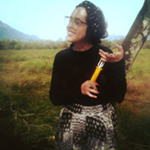from “Probable Synonyms of the Word Sololoy”
0
The boxes are read from right to left and from top to bottom. I am here to say what I heard. Christ holds a little devil popsicle. It could be a mirror, given the inscription I Am. I Am A Honeycomb. Just a little stick. The head that is not looking at me, I am. For this they have given me a good conduct award, some centuries ago. I left it there, look, next to the snails.
And my body meat. And my body upside down.
Very high up, next to the keys.
Do not open the door.
There may be more things in the bottle of quinine.
I meat all through. I dead meat.
And as if I were a fish, I shall guess them at once.
1
The meat on the plate is served, said the nana Neera. Now wait here, I gotta go for cartridges—as grandma would say, to speak of what I would see.
The house burned down. I can’t imagine this would be zebras’ work. Nor even result of the war—it was heard. An egg’s voice was, a man’s voice. (To clarify at some point that they are not the same thing.) In whichever case, the sound of three coins, three stamps, three marine fossils and many head bones next to —or above, preferably—the fishhook, and a thousand times higher than the voice.
(One must not exaggerate)
In the background, the sea, at the corner of the leaf factory.
Here, stirring, since I have left a spoon for it. And then one would listen to the airplane that will go on dropping dust over the span of the pine forest.
And the wagging meat, and the diluted crown, falling, here, into the view of the bearer.
2
The reconstruction of the cabinet of Ebodia Novena is inevitable: carrying little bone flowers in a pot that starts with an a (Hebrew) and after ten thousand things returns to three, and so on. It’s inevitable: eclipse something and enlarge your bloody cheek (sometimes yes, sometimes no) with a magnifying glass according to the date.
(We should remember that we are still inside of the end of the world.)
A line of lithium, a path of bones for dowsing right above your name. Here, perhaps, what’s eclipsed is your hair, even if I say it so as not to speak of the flag and its eagles (opals, those, angles, winged-zebras) light blue mostly dirty, and at the center.
If I raise my head, I know there will be poison, even if I won’t see it. And far behind, I know that Izunza is being read. In a crystal container that everyone will need to see, because it hangs, and it’s there. I have tried to not speak of all the elements, but one goes three times a little below the eye, and not necessarily from it I enlarge.
And mama. At the bottom of these things is always mama.
3
In order to ride a horse, especially if we are speaking from the end of the century, we must examine the box’s three points of view. The initial call: Asmodeus! Asmodeus! Comes panting with vibroplex resources, or more precisely: locomotive. The misshapen drops, the legs I don’t see. They come in turbine form and they come leaving little red dots behind, marking a helix of countryside and balconies. It is not for showing off, but this is all about a letter.
If you guessed it is because you wear your mirror differently. Your teeth guarded behind the vertical bar. No one filmed it? Just that and nothing else?
Let’s speak then of the little wires that they would put to it: 42, c3, 00, 11h.
Here probably it’s about the gut of another box. (Everything that is spoken is about the other). And it will carry nails in its name. And it will carry a handle, so you can run wild.
Asmodeus, Asmodeus: everything is in order.
(Although I still need to talk about the headgear they forced me to use the day of my first communion; and of everything else.)
4
A cocoon that something was giving birth to from concrete thorns, arrived. The little vials of elixir were on number ten. The key was also obvious and it slept (standing up) next to it. Someone was singing their desire to be a bison. Or it was the reverse. The stamp repeated: winged feet, drawn, faint and scepter.
The caduceus was a heron, for example, a sparrow or its ca-daver. Preening itself totally anonymously, already engaging the guardian:
WELCOME TO CIUDAD PROGRESO.
It was an extraordinary day which we remember as “November 20th of 1910.”
Six graves there were, but only if you looked sideways, ignoring the natural enterprise of feet. The face, it could be said, stayed questioning, in a frame entirely vectorial, defeating. At every light, challenging us with its me, me, me.
—Merino Wool.
But I think that his true name was Santa Catalina and not Bison Dreamingme, Sealed Knight, Commonsense “Gar-
cía” Guardian.
Not at all.



 BACK TO ISSUE
BACK TO ISSUE